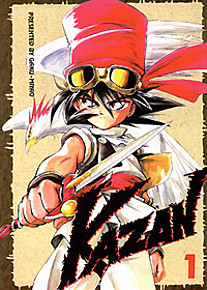Review
by Bamboo Dong,Kazan
Vol. 1
| Synopsis: |  |
||
Kazan, the only survivor of the Red Sand clan, embarks on a journey to find the water demon that destroyed his people and kidnapped his best friend Elsie. Accompanied by his eagle companion and helper, Kazan meets a mysterious girl by the name of Fawna who has the power to create water from her hands. |
|||
| Review: | |||
First published in 1997 by Shonen Gahosha in Japan, Kazan is now available in North America from the ComicsOne Corporation. Upon picking up the manga series in its graphic novel format, readers will notice one thing at the start. The English version looks just like the Japanese version, with the exception of the flipped pages. Unlike other graphic novels released in the US, the manga distributed by ComicsOne come with full-color dust jackets, mono-colored covers, and pages with the same consistencies as those of their Japanese counterparts. The back page of the jacket even has the author biography with the self-drawn caricature that many tankoubans in Japan come with. The graphic novel is even the same size as its Japanese sibling. In short, the only difference between the Japanese release of the manga and North American release is the language and the direction the pages are turned. This format of release is very commendable, and makes the manga seem much more authentic and true to the original version. The comic itself is interesting with an intriguing plot. Unfortunately, this story line is hard to discern as it is very hard to follow, and once the sequence of events is identified, the plot still remains rather confusing. Readers would be doing themselves a favor by reading through the manga more than once, as the first time around is guaranteed to leave one feeling a bit estranged. The general plot isn't the issue, as that can be gathered with relative ease; the hard parts come in occasional two-page intervals with characters that are randomly interjected, left unexplained, and left a few pages later. It's also rather hard to determine whether the narration is in the present, or a flashback to the past. With the exception of the confusing bits, the path that the story seems to be going down is intriguing. Throughout the volume, readers are hit with the awareness that water is integral to the plot, and near the end, things get interesting with the mention of a mysterious city that the adventurers are trying to find. For the most part, the scenes are wonderfully drawn. The expressions on the characters' faces are portrayed well, and it is easy for readers to see what the characters are feeling. Only Kazan looked as though his face never changed, but since his nature is one of sullen determination and anger, his static features are understandable. Barring him, the rest of the characters portray a wide range of facial expressions (though Fawna seems to be in shock throughout most of the volume). There's also a relatively amusing shot of one of the antagonists that makes him look exactly like Escaflowne's Dilandau. Also amusing were the animals that the people rode, which looked exactly like Chocobos, except that the characters actually called them horses. One thing noticeable about the art, however, was that there didn't seem to be much shading. Sometimes the shadows of a person's clothing would show on their face, but in regards to lighting effects, the characters were rather flat. Despite that, the art is consistent throughout the novel and it's easy to see why Miyao is praised for his art, especially in some of his other works like Devil Hunter Yohko.  One thing that is particularly complimentable about the translation job that ComicsOne did is the way they did the sound effects. Not only did they have ample effects, the font setting was incredible. The fonts were done to match the original Japanese type, and the hard work put into it can be seen. In fact, the fonts match the sounds well, effectively giving readers an image of what a sound effect would look like if it could be seen. The font settings range from wind-like wisps describing gushing winds, to bold thunder-like staggered print, to a crisp "crumble" that looks like rocks, well, crumbling. Kazan is a fun manga series, and its good qualities are enhanced by the magnificent job that ComicsOne did. They deserve endless praise for the format of the novel, as well as the translations, and even the font typesetting. The manga itself is also done nicely, as it makes for a light-hearted read. Although the plot is confusing at times, the art is well drawn, and the story seems to be progressing along to an exciting endpoint. In fact, this is a great chance for people without any knowledge of the Japanese language to experience Kazan in English. Undoubtedly, there are manga aficionados out there who shun all translated manga and refuse to touch anything that has been sullied by North American publishers. To those people, well, with the hard work that ComicsOne put into the release, you'll hardly notice the difference. |
| Grade: | |||
|
Story : C
Art : A-
+ ComicsOne did an amazing job with this |
|||
| Production Info: | ||
|
Full encyclopedia details about |
||